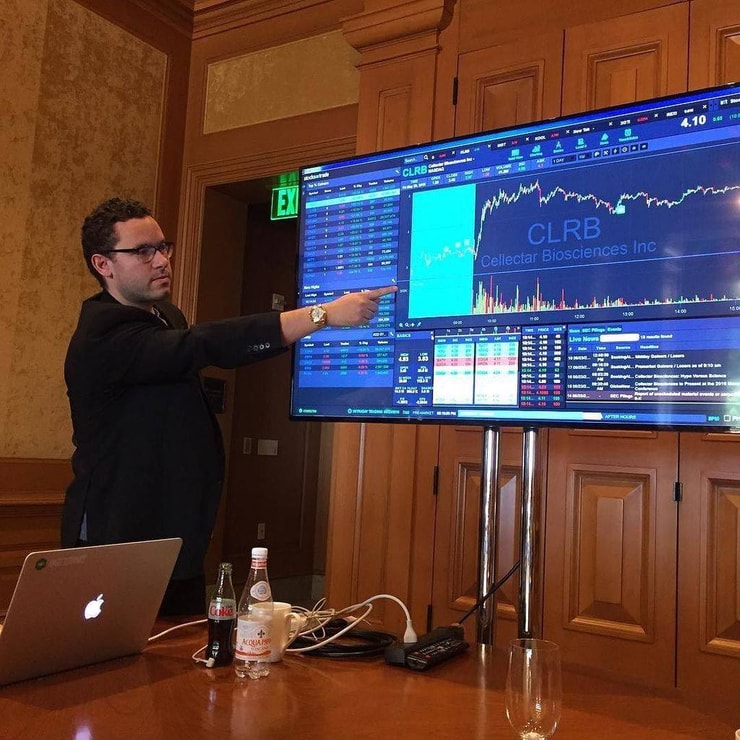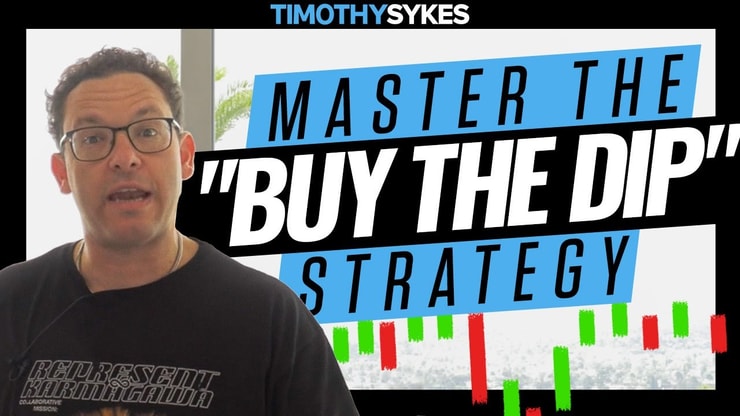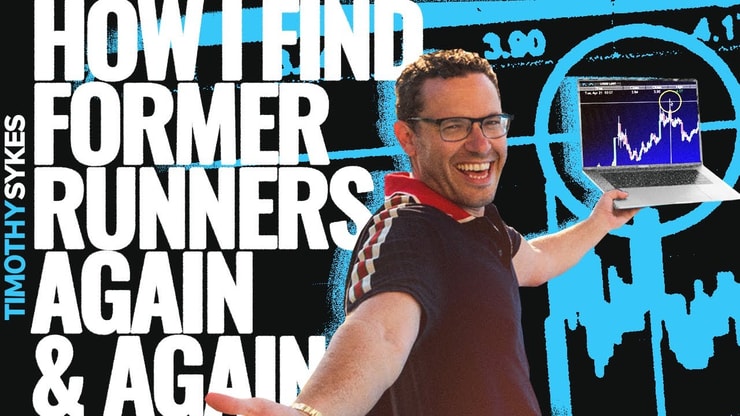A small-cap stock is stock in a company whose total value is below $2 billion. Even though these stocks can be risky, they can also lead to quick profits with a high percent gain.
In life and business, most people want to think big. But in the stock market, sometimes it pays to think small.
When you buy stock in large, established companies, you may profit over time … But that can take months or even years.
If you want to grow your account faster, consider trading stocks with more volatility. Small-cap stocks can offer greater (and quicker) returns. But you have to manage your risk, trade with a plan, and stay disciplined.
In this post, I’ll introduce you to small-cap stocks — what they are, how to find them, and how you can learn to trade them.
If you want to check out the small-cap stocks I’m watching, feel free to skip ahead.
Table of Contents
- 1 Understanding Small-Cap Stocks
- 2 Benefits of Trading Small-Cap Stocks
- 3 Top Small-Cap Stocks to Buy Now
- 3.1 #1: C3.ai, Inc. (NYSE: AI) — The AI Sector Leader Small-Cap Stock
- 3.2 #2: BigBear.ai Holdings Inc. (NYSE: BBAI) — The AI Sympathy Play Small-Cap Stock
- 3.3 #3: Netlist, Inc. (OTCQB: NLST) — The Samsung Lawsuit Winner Small-Cap Stock
- 3.4 #4: Tingo Group Inc. (NASDAQ: TIO) — The Former Runner Small-Cap Stock
- 3.5 #5: (NASDAQ: RIOT) — Riot Platforms Inc. — The Bitcoin Sympathy Small-Cap Stock
- 4 Best Value Small-Cap Stocks
- 5 Strategies for Trading Small-Cap Stocks
- 6 Factors to Consider Before Purchasing Small-Cap Stocks
Understanding Small-Cap Stocks

Market capitalization, or market cap, is the market value of a company’s outstanding shares. It’s an important metric for traders — it’s a way to gauge a company’s size.
Figuring out market cap is easy. Multiply the total number of shares by the current share price. So if a company has one million shares trading at $5 each, the market cap is $5 million.
Knowing a company’s market cap can help you with your technical and fundamental analysis. It can be a useful way to filter stocks to see which ones might be interesting. It can also help you add diversity to your portfolio.
So what’s a small-cap stock?
A small-cap company is one with a market cap between $300 million and $2 billion.
If that sounds pretty large, that’s because it is. But a mega-cap company might have a market cap of $200 billion or higher. Compared with that, the small-cap company is small potatoes.
It’s important to understand how they stack up against their larger counterparts. Large-cap stocks, for instance, offer stability and are often industry leaders. Want to understand the differences better? Here’s a comparative analysis of large-cap vs small-cap stocks.
Penny stocks usually fall into the micro- or nano-cap category, which is everything below the small-cap cutoff.
Benefits of Trading Small-Cap Stocks

Small-cap stocks offer numerous benefits, from high growth potential to less competition. But day trading them isn’t the only way to go about it. Swing trading, which involves holding stocks for days or weeks, can also be a profitable strategy. It allows you to take advantage of short-term trends while avoiding the stress of day trading. Interested in this approach? Dive into this detailed article on swing trading strategy.
Both strategies take advantage of these benefits…
Trends Track the Larger Market
You can potentially benefit from the same global trends that affect large-cap stocks. You can look at trending sectors in the large-cap world and see if there are similar opportunities among the small caps.
The information is more easily available for bigger businesses. Their activity is tracked, any change in major shareholders is reported, the source of advice on their moves is usually more trustworthy.
Opportunity for Individual Traders
Large-cap stocks are better known, but there can be plenty of trading opportunities with small caps.
Many big investors think small-cap stocks are a waste of time. They also turn up their noses at penny stocks because they’re too volatile and risky.
That higher volatility is what I love about these lower-priced stocks. It’s all about your strategy. Don’t know where to start?
Check out my FREE online penny stock guide.
Room for Growth
The smaller the cap, the more room there is to grow.
Small-cap stocks are generally lesser-known companies. But they stand to grow their revenue and earnings over time. If they do well, demand for their shares will grow.
If you can be ahead of the curve, you may benefit.
Less Analyst Coverage
A product launch for a small-cap company can have a much bigger impact on the stock price. But since smaller companies don’t get as much analyst coverage, it’s up to you to discover these opportunities.
Unless you use a smart tool like StocksToTrade’s Breaking News Chat. Two Wall Street analysts sift through all the market news to alert traders to the items that can supercharge stock moves. This is a tool I use — and it’s also one I helped to design.
Takeover Potential
Big companies move slowly. When a large company wants to expand, it’s often easier and quicker to buy a small-cap company instead of starting a new division or product line.
That means potential opportunities for traders … A small-cap company’s stock can jump on news of an acquisition. Just be prepared with a plan. I wouldn’t hold and hope with these kinds of catalysts.
Retweet this if you promise to finish the week strong, no #HODLing or hoping & holding while a position goes against you, no getting too greedy & going for home runs instead of singles, no following anyone else's alerts, but instead working to optimize your own strategy/process!
— Timothy Sykes (@timothysykes) March 3, 2023
Top Small-Cap Stocks to Buy Now
Let’s go over some small-caps to put on your radar for 2023:
- (NYSE: AI) — C3.ai, Inc. — The AI Sector Leader Small-Cap Stock
- (NYSE: BBAI) — BigBear.ai Holdings Inc. — The AI Sympathy Play Small-Cap Stock
- (OTCQB: NLST) — Netlist, Inc. — The Samsung Lawsuit Winner Small-Cap Stock
- (NASDAQ: TIO) — Tingo Group Inc. — The Former Runner Small-Cap Stock
- (NASDAQ: RIOT) — Riot Platforms Inc. — The Bitcoin Sympathy Small-Cap Stock
Before you send in your orders, take note: I have NO plans to trade these stocks unless they fit my preferred setups. This is only a watchlist.
The best traders watch more than they trade. That’s what I’m trying to model here. Pay attention to the work that goes in, not the picks that come out. Soon, you’ll be able to make your own lists.
Subscribe to my NO-COST weekly stock watchlist newsletter here!
#1: C3.ai, Inc. (NYSE: AI) — The AI Sector Leader Small-Cap Stock
My first small-cap stock pick is C3.ai, Inc. (NYSE: AI).
In April 2023, AI broke down through the $20 support it had been holding for nearly three months…
That puts it back in small-cap range, and puts it in my sights for my favorite pattern:
Understand — I’m not telling you to buy and hold the dip…
When a stock like AI panics on news like its recent analyst downgrade, it often results in a bounce.
When the stock doesn’t bounce, I cut my losses. But if AI is headed for a price correction, there will be plenty of trade opportunities along the way.
I’m not predicting a collapse. AI stock is the AI sector leader. The future of the sector is bright.
I’m not predicting anything, I’m just reading the chart. Take a look at AI’s spike in early April. Former runners can run again.
#2: BigBear.ai Holdings Inc. (NYSE: BBAI) — The AI Sympathy Play Small-Cap Stock
My second small-cap stock pick is BigBear.ai Holdings Inc. (NYSE: BBAI).
I prefer to trade penny stocks to higher-priced stocks like AI. A penny stock sells for under $5 a share.
Although it broke out in February 2023, BBAI is back in penny stock land as of April.
I think penny stocks are better for small account traders. They tend to move more than higher-priced tickers. Their percentage gains are greater.
Traders know this. When a higher-priced ticker is moving, many will gravitate toward a lower-priced ticker like BBAI. That’s what makes it a sympathy play — it benefits from sector momentum, even if it has no catalyst itself.
I’ve got a warning for you as well — this young sector doesn’t bounce as well as other sectors. I found that out when BBAI fell past its support on the back end of a spike. This lesson cost me $5,584 (starting stake $87,381).
I’m transparent about my losses because knowing how to lose is half of trading…
Even though I kept my percentage loss small at just over 6%, it was still a hugely undisciplined trade. I chased.
While it's good to cut losses quickly, if you ever have a big loss, don't fret as they are the best teachers even if they're also the most painful. The key is just learning what you did wrong & not repeating that mistake so don't be like most Twitter traders & hide any big losses
— Timothy Sykes (@timothysykes) October 11, 2021
I’ve learned to be a bit more careful with AI stocks. It’s a new hot sector, and the market doesn’t know how to value it yet.
I’m watching BBAI for A+ setups, and won’t trade it again until I see one.
#3: Netlist, Inc. (OTCQB: NLST) — The Samsung Lawsuit Winner Small-Cap Stock
My third small-cap pick is Netlist, Inc. (OTCQB: NLST).
In late April, NLST won a landmark case against Samsung for patent infringement. This goosed its share price up 40%…
But if you look at its chart, NLST’s real gains came earlier in 2023. It gained more than 250% in the year’s first four months.
I’ve traded this ticker for $6,238 in total profits (click the link to see my individual trades). A big chunk of those gains came off a spike three years ago — after NLST won a lawsuit against Alphabet Inc. (NASDAQ: GOOGL)!
Former runners can run again — especially if they get the kind of tasty news that NLST is prone to.
#4: Tingo Group Inc. (NASDAQ: TIO) — The Former Runner Small-Cap Stock
My fourth small-cap stock pick is Tingo Group Inc. (NASDAQ: TIO).
Speaking of former runners, let’s take a look at TIO. It had three big runs in 2020 and 2021, then fell below the $1 mark for most of 2022.
It had a 100% run toward the end of 2022, then tried to break through resistance again at the start of 2023.
In April, it ran again on earnings — then broke out to 2021 levels after it announced that it had regained compliance with Nasdaq’s minimum bid price requirement.
This is a stock that wants to run. I’d go so far to say it was born to run. But it’s also shown it can collapse just as quickly.
This is good for us traders.
Your job as a trader is to profit from volatility, do NOT fall in love with any trade or asset as a trade is not profitable until you lock in your profits & getting emotional can muddy the waters. Similarly, it's difficult to cut losses fast if you become too emotionally involved
— Timothy Sykes (@timothysykes) December 7, 2021
Whether we’re trading an uptrend or a downtrend, we need movement. That gives us the freedom to take singles as it moves around the chart.
#5: (NASDAQ: RIOT) — Riot Platforms Inc. — The Bitcoin Sympathy Small-Cap Stock
My fifth small-cap pick is Riot Platforms Inc. (NASDAQ: RIOT).
But it might not be a small-cap for long…
Watch $MARA $RIOT Bitcoin stocks as Bitcoin $BTC is spiking higher
— Timothy Sykes (@timothysykes) October 21, 2020
We’ve seen this film before. RIOT got all the way up to $71 in 2021…
In April 2023, it was back under $12. Like fellow bitcoin miner Marathon Digital Holdings Inc. (NASDAQ: MARA), its fortunes are tied to that of the biggest cryptocurrency.
But check out the charts. While bitcoin gained 79% from January–April 2023, RIOT gained almost 250%! MARA was up just over 200%.
This goes back to the reason I watch small-cap stocks. Bitcoin is unique for the amount of movement it has as a higher-priced asset…
But it still can’t compare to similar assets that have a radically lower bar to entry.
RIOT might continue to climb higher. Or it might fall, or consolidate.
Either way, it’s worth watching.
Best Value Small-Cap Stocks
Some traders want the best of both worlds — value stocks with a small investment.
First, I want to tell you that this isn’t my trading strategy. The premise of value stock investing is keeping your money tied up in a supposedly “safe” stock.
No stocks are “safe.” If you want safety, get a CD from your bank.
Moreover, the rate of return promised by value stocks will only keep large account holders content — those of us with day jobs and credit cards to pay off will probably want more than 10% annual gains.
That said, it doesn’t hurt to check out a different approach than the technical one I use most…
Value trading relies on a certain amount of fundamental analysis. While I’m a believer in the fact that “only price pays,” there are some tricks to be gleaned from the value camp.
One of the big problems in the small-cap world is the fact that too many of these companies are scams. As you dip below the $1 billion threshold, the scammers get more brazen.
The Russell 2000 Index features some of the more legit tickers. There are even ETFs based on its list.
When you’re doing your research, you can check things like management, performance compared to industry peers, or even nerdy data like price-to-earnings ratio (EPS).
Strategies for Trading Small-Cap Stocks

My strategies for trading small-cap stocks differ from the ones for trading large-cap stocks…
Trading small-cap stocks requires a specific approach. Day trading is one such strategy that can be particularly effective with these volatile stocks. It involves buying and selling stocks within a single trading day, capitalizing on short-term price movements. Want to master this approach? Check out this comprehensive guide on day trading strategy.
Small cap stocks tend to follow patterns better. That’s why I developed my 7-step penny stocking framework…
Remember this chart well, its the basis for my 7-step framework, @30DayBoot & @completepenny & you must study not to fall prey to greed/ignorance or you'll get wrecked like 90% of traders. It's VITAL to sell into excessive strength/hype, do not just hold & hope like most newbies pic.twitter.com/QsAGHsI6lp
— Timothy Sykes (@timothysykes) February 28, 2021
Of course, we might be getting ahead of ourselves. Before you even think about trading, make sure you have the following pieces in place:
- Watchlist: A good stock screener like StocksToTrade will help you build your watchlist. You want to find one which has the right tools for stock analysis, integrates with a lot of brokers, and works for beginners as well as it works for experts — like StocksToTrade.
Take a look at the stocks I’m watching this month here.
- Knowledge: You have to know what you’re looking for. Study chart patterns by yourself or with a mentor, like in my Trading Challenge.
Apply to join my Trading Challenge here!
- Trading plan: Never trade without a plan! This is the only way to maintain discipline in trading. The path of no discipline leads to random trades and overtrading, snowballing greed, and eventually BIG losses.
Factors to Consider Before Purchasing Small-Cap Stocks

Here are some additional considerations before pulling the trigger…
- Partnerships. It helps to have the backing of venture capital firms or other funds. Big name shareholders can also move the needle.
- The macro-economy. Consider factors like interest rates and other economic factors — even the price of crude oil and mortgage rates can affect the markets.
- Equity. Things like dividends, technology rights, forthcoming products and services, and sales predictions can all be part of the value picture.






Leave a reply